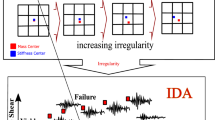Abstract
Performance-based earthquake engineering is a recent focus of research that has resulted in widely developed design methodologies due to its ability to realistically simulate structural response characteristics. Precise prediction of seismic demands is a key component of performance-based design methodologies. This paper presents a seismic demand evaluation of reinforced concrete moment frames with medium ductility. The accuracy of utilizing simplified nonlinear static analysis is assessed by comparison against the results of time history analysis on a number of frames. Displacement profiles, drift demand and maximum plastic rotation were computed to assess seismic demands. Estimated seismic demands were compared to acceptance criteria in FEMA 356. The results indicate that these frames have sufficient capacity to resist interstory drifts that are greater than the limit value.
Similar content being viewed by others
References
Barros RC and Almeida R (2005), “Pushover Analysis of Asymmetric Three-dimensional Building Frames,” Journal of Civil Engineeringand Management, 11(1): 3–12.
Building and Housing Research Center (BHRC) (2005), Iranian Code of Practice for Seismic Resistant, Design of Buildings, Standard No. 2800-05, 3rd Edition, Building and Housing Research Center, Tehran, Iran.
Chopra Ak and Goel RK (2002), “A Modal Pushover Analysis Procedure for Estimating Seismic Demands for Buildings,” Earthquake and Structural Dynamics, 31: 561–582.
ElHowary HA and Mehanny SSF (2011), “Seismic Vulnerability Evaluation of RC Moment Frame Buildings in Moderate Seismic Zones,” Earthquake Engineering & Structural Dynamics, 40: 215–235.
Fajfar P and Fischinger MM (1988), “N2-a Method for Non-linear Seismic Analysis of Regular Structures,” Proceedings of the Ninth world Conference on Earthquake Engineering, Vol. 5, Tokyo, Japan.
FEMA 356 (2000), Prestandard and Commentary for the Seismic Rehabilitation of Buildings (FEMA 356) Prepared by American Society of Civil Engineers for the Federal Emergency ManagementAgency, Washington (DC).
Han SW, Kim ES and Hwang SM (2007), “Variability of Seismic Demands according to Different Sets of Earthquake Ground Motions,” The Structural Design of Tall and Special Buildings, 16: 321–332.
Huang K and Kuang JS (2010), “On the Applicability of Pushover Analysis for Seismic Evaluation of Medium- and High-rise Buildings,” The Structural Design of Tall and Special Buildings, 19: 573–588.
Iwan WD (1999), “Implications of Near-fault Ground Motion for Structural Design,” Proceedings of US-Japan Workshop on Performance-Based Earthquake Engineering Methodology for RC Building Structures, Maui, Hawaii, U.S.A. (available from PEER, UC Berkeley, U.S.A.).
Kalkan E (2006), “Prediction of Seismic Demands in Building Structures,” Ph.D. Dissertation, University of California, Davis.
Kalkan E and Kunnath SK (2006), “Adaptive Modal Combination Procedure for Nonlinearstatic Analysis of Building, Structures,” Structural Engineering, 132(11): 1721–1731.
Kalkan E and Kunnath SK (2007), “Assessment of Current Nonlinear Static Procedures for Seismic Evaluation of Buildings,” Engineering Structures, 29(3): 305–316.
Kim S and Kurama Y (2008), “An Alternative Pushover Analysis Procedure to Estimate Seismic Displacement Demands,” Engineering Structures, 30: 3793–3807.
Kim T and Kim J (2009), “Seismic Demand of an RC Special Moment Frame Building,” The Structural Design of Tall and Special Buildings, 18: 137–147.
Krawinkler H, Seneviratna GDPK (1998), “Pros and Cons of a Pushover Analysis for Seismic Performance Evaluation,” Engineering Structures, 20(4–6): 452–464.
Kunnath SK and Gupta SK (2000), “Validity of Deformation Demand Estimates Using Nonlinear Static Procedures,” Proceedings of US-Japan Workshop on Performance-based Earthquake Engineering Methodology for RC Building Structures, Sapporo, Japan.
Kunnath SK and John Jr A (2000), “Validity of Static Procedures in Performance-based Seismic Design,” Proceedings of ASCE Structures Congress, Philadelphia, U.S.A.
Kunnath SK and Kalkan E (2004), “Evaluation of Seismic Deformation Demands Using Non-linear Procedures In Multistory Steel and concrete Moment Frames,” ISET Journal of Technology, 41(1): 159–181.
Mao Jianmeng, Zhai Changhai and Xie Lili (2008), “An Improved Modal Pushover Analysis Procedure for Estimating Seismic Demands of Structures,” Earthquake Engineering and Engineering Vibration, 7(1): 25–31.
Miranda E (1997), “Estimation of Maximum Interstory Drift Demands in Displacement-based Design,” In Seismic Design Methodologies for the Next Generation of Codes, Fajfar P, Krawinkler H (eds). .....Balkema; Rotterdam.
Mortezaei A, Ronagh HR, Kheyroddin A and Ghodrati Amiri G (2011), “Effectiveness of Modified Pushover Analysis Procedure for the Estimation of Seismic Demands of Buildings Subjected to Near-fault Earthquakes Having Forward Directivity,” The Structural Design.of Tall and Special Buildings, Published online in Wiley Online Library, DOI: 10.1002/tal.553.
Nguyen A, Chintanapakdee C and Hayashikawa T (2010), “Assessment of Current Nonlinear Static Procedures for Seismic Evaluationof BRBF Buildings,” Journal of Constructional Steel Research, 66: 1118–1127.
Prakash V, Powell GH and Campbell S (1993), DRAIN-2DX Base Program Description and User Guide, Department of Civil Engineering University of California, Berkeley.
Ruiz-García J and Miranda E (2010), “Probabilistic Estimation of Residual Drift Demands for Seismic Assessment of Multi-story Framed Buildings,” Engineering Structures, 32: 11–20.
Seneviratna GDPK and Krawinkler H (1997), “Evaluation of Inelastic MDOF Effects for Seismic Design,” John A. BlumeEarthquake Engineering Center Report No. 120, Department of Civil Engineering, Stanford University.
Somerville P, Smith N, Puntamurthula S and Sun J (1997), “Development of Ground Motion Time Histories for Phase 2 of the FEMA/SAC Steel Project,” Report No. SAC/BD 97/04, SAC Background Document, SAC Joint Venture: Richmond, CA.
Vamvatsikos D and Fragiadakis M (2010), “Incremental Dynamic Analysis for Estimating Seismic Performance Sensitivity and Uncertainty,” Earthquake Engineering & Structural Dynamics, 39: 141–163.
Author information
Authors and Affiliations
Corresponding author
Rights and permissions
About this article
Cite this article
Ghaffarzadeh, H., Talebian, N. & Kohandel, R. Seismic demand evaluation of medium ductility RC moment frames using nonlinear procedures. Earthq. Eng. Eng. Vib. 12, 399–409 (2013). https://doi.org/10.1007/s11803-013-0181-1
Received:
Accepted:
Published:
Issue Date:
DOI: https://doi.org/10.1007/s11803-013-0181-1




